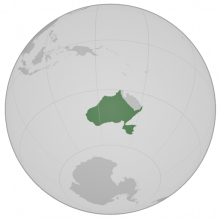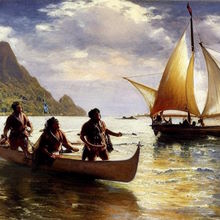New Holland
| This article reflects New Holland on 1 January 1989. |
| Dominion of New Holland Te Tominiona o Niu Hōrana | |
|---|---|
|
Motto: Onward | |
 Dominion of New Holland, excluding other territories and states within the Realm of New Holland. | |
| Capital |
Gloucester 47°5′S 164°1′E |
| Largest city |
Georgetown 44°3′S 143°5′E |
| Official languages |
English a Mātou French b |
| Ethnic groups (1985) |
?% European ?% Matoū ?% Asian ?% Pacific Islander ?% Other |
| Religion |
?% Anglican ?% Presbyterian ?% Catholic ?% Other Christian ?% Other Religion ?% No Religion ?% Not Stated |
| Demonym | New Hollander |
| Government | Unitary parliamentary constitutional monarchy |
• Queen | Elizabeth II |
• Governor General | James Lewis |
• Prime Minister | Elizabeth Norton |
| Legislature |
New Holland Parliament (House of Representatives) |
| Independence from the United Kingdom | |
• Federation | 1870s |
• Constitution Act | 1890s |
• Statute of Westminster | 1940s |
| Area | |
• Total | 3,812,345 km2 (1,471,955 sq mi) (6th) |
• Water (%) | 1.65 |
| Currency | New Holland Dollar ($) (NHD) |
| Time zone |
Western New Holland Time (UTC+10) Central New Holland Time (UTC+11) Eastern New Holland Time (UTC+12) |
| Date format | dd/mm/yyyy |
| Drives on the | left |
| Calling code | 61 |
| ISO 3166 code | NH |
| |
Contents
Etymology
History
Human Settlement
New Holland was one of the last major land masses to be settled by humans. The indigenous Matoū were the first to arrive. Originally from Polynesia, these seafaring pioneers crossed the Pacific Ocean in large double-hull canoes propelled by sail. Determining the exact date of their arrival is difficult and estimates vary. The earliest archaeological evidence, a bone from the exotic Polynesian rat, has been dated to approximately 950 CE. This indicates that New Holland was settled concurrently with the Cook Islands some 3000 kilometres (1864 miles) north-east. However, deforestation in northern New Holland has been tenuously linked with Matoū settlement as early as 300 CE. It is ultimately unclear whether this deforestation is anthropogenic in nature. Some historians assert that Matoū oral traditions indicate human settlement between 400 and 600 CE, while others speculate that Matoū sailors periodically visited New Holland for centuries before social upheaval in their homeland forced actual migration. It is hoped that emerging genetic studies and improved archaeological techniques will shed more light on Matoū settlement. Regardless, it is almost certain that New Holland was permanently settled by 1000 CE.The first Matoū on the continent settled what is now Roheraki and spread from there to all corners of New Holland. Their society was quite different to that which existed when Europeans arrived in the 16th century. Larger social units such as iwi (tribe) and hapu (subtribe) were less important as most Matoū lived in isolated whanau or family groups. Hunting, fishing, and gathering were the primary sources of food. While early Matoū were certainly capable of agriculture, it was a secondary source. The fortified villages or pa associated with later Matoū did not exist. Land and food was in abundance, and the competition over natural resources necessitating their construction had yet to arrive. There are areas in which early Matoū society was less distinct. Mythology and oral tradition, for example, has remained significant throughout Matoū history.
European Discovery
The first recorded European sighting of New Holland occurred in 1619 when the Veritie, an English ship under the command of Edward Burton, stumbled upon its western coast. Burton had been instructed to exploit the Brouwer Route discovered by Dutch navigator Hendrik Brouwer eight years prior. His employers, the English East India Company, had yet to exploit the route. Burton relied on Dutch descriptions of the route which failed to account for the reduced distance between meridians at southerly latitudes. When calm winds forced Veritie to seek winds as far south as 45°, Burton was inclined to overshoot the point at which he was supposed to turn north. Other factors, such as the inability to determine speed and longitude accurately, exacerbated the issue. Thus, Burton found himself off the coast of New Holland some 2,400 kilometres (1,491 miles) east of his intended turning point. Burton's exploration of New Holland was brief. He landed to take on water at a location now called Veritie Bay and then sailed north along the coast until it turned eastward. Veritie subsequently sailed onward to the East Indies and Surat in India. There is no record of Veritie encountering the indigenous people of New Holland.
While Burton's discovery of New Holland is undisputed, some assert that other European seafarers reached the continent earlier. Java le Grande, a landmass which appears in 16th century French maps, is sometimes associated with New Holland. Other 16th century maps show Terra Australis, the hypothetical southern continent, in New Holland's vicinity. These maps are said to be proof of New Holland's exploration by Europeans a century before Burton's voyage. However, most modern historians reject these claims. In 1975 a small horde of Ming dynasty coinage was discovered on Dalrymple Island. Minted in the early 15th century, the exact origin of these coins and the date of their burial is unclear. Though no robust evidence exists, it has been argued that a Portuguese ship carrying these coins visited Dalrymple Island at some point before Burton's voyage. Unfortunately, military-related construction at the site has precluded further investigation.
There was little interest in New Holland following Burton's return to England. The known coastline was marked on English maps as Smythe's Land, after Sir Thomas Smythe who governed the East India Company, and largely ignored until Dutch explorer Abel Tasman embarked on a voyage of discovery in 1642. The Council of the Indies assumed that Smythe's Land was the westernmost extremity of Beach or Locach, a wealthy country south of China identified by Marco Polo. They instructed Tasman, a captain of the Dutch East India Company, to follow the Brouwer Route and obtain further knowledge of Beach and its riches. Two ships, Heemskerck and Zeehaen, were provided for the expedition.
Tasman departed Batavia in August 1642 and arrived in Mauritius the following month. From there, his ships sailed south into the Roaring Forties and followed the Brouwer Route east towards Smythe's Land. Land was sighted 2 December. Two days later Heemskerck and Zeehaen took on water near the present location of Ruataniwha and then sailed north. In contrast to Burton, Tasman and his ships followed the coastline as it turned east and charted the northern edge of New Holland. A number of landings took place over the following month. However, the wealth of Beach eluded Tasman. Beyond the dense rainforest adorning Smythe's Land, he found a dry wasteland bereft of riches populated by "violent savages". His opinion of the Matoū was no doubt tainted by a hostile encounter at Black Bay in which Zeehaen was surrounded and attacked by a Matoū war party in waka. Tasman nevertheless claimed New Holland in the name of the Dutch East India Company and, recognising that it was not the fabled Beach, named it after the largest province of the Netherlands. He also named the dry region adjacent the northern coast Staten Landt, in honour of the States General.
Heemskerck and Zeehaen departed New Holland's coast at the northernmost point of Roheraki around New Year's Eve. Tasman noted that the climate appeared to change as the coastline turned south and, upon returning to Batavia in June 1643, recommended that another expedition might find land suitable for exploitation beyond Staten Landt.
Geography
New Holland resides on a continent of the same name, which it shares with Roheraki. The continent of New Holland is the smallest landmass recognised as such, with a land area approximating 4,396,935 km2 (1,697,666 square miles). It is surrounded by the Indian, Southern, and Pacific oceans which lie to the west, south, and east respectively. The Janszoon Sea, a marginal sea of the Indian Ocean, hugs the northwestern coast. New Holland the country occupies 3,812,345 km2 (1,471,955 square miles) and is sixth largest in the world. The Realm of New Holland, which encompasses territories administered by or freely associated with New Holland, also includes a number of islands across the Pacific Ocean and Indian Oceans. New Holland also claims the Ross Dependency which lies between 150°W and 44°38'E, except for those lands between 136°E and 142°E which are claimed by France as Adélie Land.
Mainland New Holland lies between 141°W



